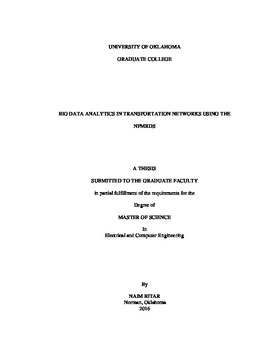| dc.description.abstract | Urban traffic congestion is common and the cause for loss of productivity (due to trip delays) and higher risk to passenger safety (due to increased time in the automobile), not to mention an increase in fuel consumption, pollution, and vehicle wear. The fiduciary effect is a tremendous burden for citizens and states alike. One way to alleviate these ill effects is increasing state roadway and highway capacity. Doing so, however, is cost prohibitive. A better option is improving performance measurements in an effort to manage current roadway assets, improve traffic flow, and reduce road congestion.
Variables like segment travel time, speed, delay, and origin-to-destination trip time are measures frequently used to monitor traffic and improve traffic flow on the state roadways. In 2014, ODOT was given access to the FHWA’s National Performance Management Research Data Set (NPMRDS), which includes average travel times divided into contiguous segments with travel time measured every 5 minutes. Travel times are subsequently segregated into passenger vehicle travel time and freight travel time. Both types of time are calculated using GPS location transmitted by way of participating drivers traveling along interstate highways.
This thesis presents research detailing the use of NPMRDS dataset consisting of highway vehicle travel times, for computing performance measurements in the state of Oklahoma. Data extraction, preprocessing, and statistical analysis were performed on the dataset. A comprehensive study of the dataset characteristics, including influencing variables that affect data measurements are presented. A process for identifying anomalies is developed, and recommendations for improving accuracy and alleviating data anomalies are reported. Furthermore, a process for filtering and removing speed data outliers across multiple road segments is developed, and comparative analysis of raw baseline speed data and cleansed data is performed. Identification and computational comparison of travel time reliability performance measurements is done. A method for improved congestion detection is investigated and developed. Finally, traffic analytics using machine learning is performed to identify and to classify congested segments and a novel approach for identifying non-recurrent congestion sources using Bayesian inference of speed data is also developed and introduced. | en_US |
